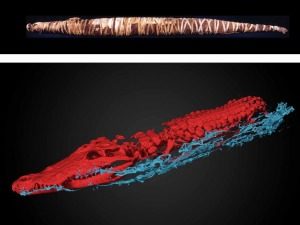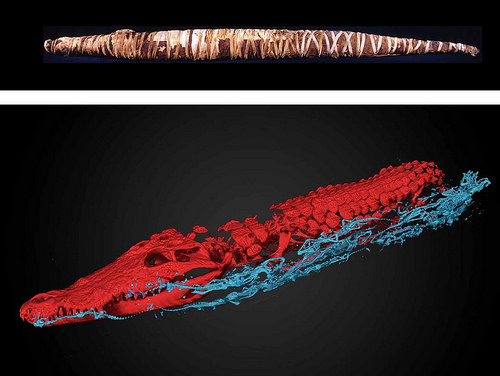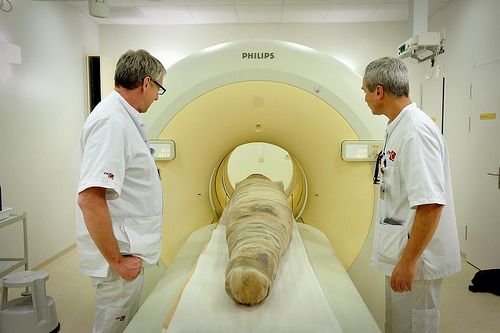
A three-metre-long mummified Egyptian ‘giant crocodile’, one of the finest animal mummies in the Dutch National Museum of Antiquities (Rijksmuseum van Oudheden), turns out to be literally filled with surprises. Examination of detailed new 3D CT scans has led to the conclusion that, besides the two crocodiles previously spotted inside the wrappings, the mummy also contains dozens of individually wrapped baby crocodiles. This is an exceptional discovery: there are only a few known crocodile mummies of this kind anywhere in the world. Starting on 18 November, museum visitors can perform a virtual autopsy on the 3,000-year-old mummy, using an interactive visualisation exhibit in the new Egyptian galleries.
Virtual autopsy in museum galleries
A new scan of the large crocodile mummy was recently performed at the Academic Medical Centre (AMC) in Amsterdam. An earlier CT scan in 1996 had shown that there are two juvenile crocodiles inside a mummy that looks like one large crocodile. The Swedish company Interspectral, which specializes in high-tech interactive 3D visualizations, has converted the results of the new scan into a spectacular 3D application and thus detected the dozens of baby crocodiles. Starting on 18 November, museum visitors can perform an interactive virtual autopsy on the crocodile mummy and the mummy of an Egyptian priest. On a large touch screen, they can examine the mummies layer by layer, learning about their age, physical features, and the mummification process. The amulets placed inside the linen wrappings with the mummies can also be examined in detail and from all sides in 3D.
______________________________________
Mummy and scan results of ancient Egyptian crocodile mummy with baby crocodiles. Courtesy Interspectral and Rijksmuseum van Oudheden/National Museum of Antiquities.
____________________________________________________
Crocodile mummy undergoing scanning. Courtesy Mike Bink
__________________________________________________
A surprise
The museum’s Egyptologists suspect that the crocodiles of different ages were mummified together as a reference to the ancient Egyptian belief in rejuvenation and new life after death. Another possibility is that no large crocodiles were available at a time when they were needed as offerings to the gods. The mummy was given the shape of one large crocodile with various kinds of stuffing: bits of wood, wads of linen, plant stems, and rope.
The ancient Egyptians mummified all sorts of animals, usually to pay homage to a particular deity that could manifest in animal form. For instance, crocodiles were offered to the god Sobek.
The museum’s curator are excited about this remarkable find: ‘What was intended as a tool for museum visitors, has yet produced new scientific insights. When we started work on this project, we weren’t really expecting any new discoveries. After all, the mummy had already been scanned. It was a big surprise that so many baby crocodiles could be detected with high- tech 3D scans and this interactive visualization.’
Source: Rijksmuseum van Oudheden/National Museum of Antiquities press release.
_________________________________________________

______________________________________________
Travel and learn with Far Horizons.
____________________________________________
This richly illustrated issue includes the following stories: Recent findings shedding new light on the whereabouts of the remains of Philip of Macedon, father of Alexander the Great; how an archaeologist-sculptor is bringing bones of the dead back to life; archaeologists uncovering town life at the dawn of civilization; an exclusive interview with internationally acclaimed archaeologist James M. Adovasio about what makes the Meadowcroft Rockshelter prominent in the ongoing search for the first Americans; what archaeologists are finding at the site of the ancient city of Gath, the home town of the biblical Philistine giant, Goliath; and how scientists are redrawing the picture of human evolution in Europe. Find it on Amazon.com.









